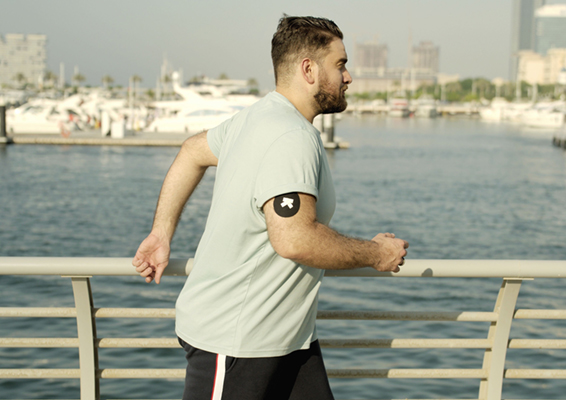Whether we’re conscious of it or not, we’ve all subscribed to diet culture’s repeatedly reinforced notion that furious calorie-counting, step-tracking and switching from one fad diet to the next is the way to fat-burning and killer abs. But we’re here to ruin the get-thin-quick party with science: the human body is a lot more complex than that, and healthy weight loss involves a deeper understanding of how hormonal and biochemical pathways factor into weight loss and weight gain in the body. Let’s take a closer look at how the body maintains a balance of energy and how it all ties into weight loss before we get to what does work and how continuous glucose monitoring fits into this puzzle.

Highlights
- When you fail to keep your insulin levels in check, your body gets stuck in fat storage mode,
- Keeping sugar levels within the normal range and making sure insulin levels don’t spike, is central to healthy weight loss,
- There is no such thing as a universally recommended diet. Nutrition is a highly personalised affair.
The Starring Role of Insulin in Burning Fat
When we eat, the carbs we’ve consumed get broken down into glucose, which is the body’s primary source of energy. When glucose enters the bloodstream, it is the hormone insulin that transports it to the cells where it is converted into energy. When we’re lounging around doing nothing over the weekend or chained to a desk at a day job, the excess sugar gets stored in the liver as glycogen. When the liver hits full capacity, the glucose sets up camp in the fat cells, like triglycerides. Between meals, insulin levels go down since there’s no need to transport glucose to the cells. But the body (heart, lungs, brain and every organ system) still needs a steady supply of energy for basic functioning, so it starts to tap into glycogen reserves. When glycogen is exhausted, it starts to use up fat stores and voila, we lose weight!
Now imagine your insulin levels are chronically high, thanks to too much sugar circulating in the bloodstream. Then you develop insulin resistance, which is a condition where your cells don’t respond normally to insulin. So instead of glucose entering the cells and getting converted to fuel for the body, it remains in the bloodstream. The body responds by producing more insulin to transport the sugar to the cells but this only exacerbates the problem because when insulin levels remain high, the body does not get the memo to use up glycogen and burn fat stores for energy. So weight loss becomes frustrating if not impossible.
So what happens if you fail to keep your insulin levels in check? Your body gets stuck in fat storage mode rather than fat-burning mode. Keeping blood sugar levels within the normal range and making sure insulin levels don’t spike, is central to healthy weight loss.
Blood Glucose Vs Calories Model
Before we go into why the calorie-counting model is flawed when it comes to weight loss, let’s look at what studies tell us about the many factors that influence glucose variability; and the importance of understanding and controlling our blood sugar levels.
- There is no such thing as a universally recommended diet. Research tells us that different people eating the same meal might have highly variable glucose responses,
- Low-carb diets are not the answer. Different meals with the same amount of carbohydrates can produce highly variable glucose levels in the same person,
- Lifestyle factors play a key role in blood sugar regulation. Stress and how much and how well you sleep, have a say in your glucose levels,
- Sometimes it’s about when you eat rather than what you eat and the food combination. A high-calorie, high-glycemic meal eaten in the evening can send your blood sugar and insulin out of whack, but the same meal consumed in the morning may not have the same impact. The sequence in which you eat your food also matters. Begin a meal by eating vegetables and protein and/or fat, and finish it off with starches and carbohydrates.
It’s easy to see why keeping an eye on your blood sugar and insulin levels — ensuring they’re well within control — as opposed to lowering calorie intake, is the most effective path to healthy weight loss. The calorie-counting model operates on the assumption that the less food we put in our body, the more we burn our fat stores for energy to get us through the day. But for all the aforementioned reasons, we can see that the process of energy usage, weight gain and weight loss is not nearly as simple or straightforward as this.
Fad Diets Impair Weight Loss
Now that we understand the intricacies of weight loss, it shouldn’t be surprising to learn that the long-term success rates of diets for weight loss are beyond discouraging. According to Ochner et al, “this almost ubiquitous weight regain is witnessed in virtually every clinical weight-loss trial.” Our ability to maintain the weight we’ve lost is also determined by the kind of food we consume after the weight loss. As another study pointed out, those who were on low-carb diets after weight-loss, lost 200 kilocalories more per day than those who were on high-carb diets. Calorie deprivation affects the brain as well. Studies show that there is increased brain activity when we’re calorie deprived, causing us to focus excessively on obtaining food.
Leptin Resistance and Weight Loss
Another hormone that plays a crucial role in weight loss is the satiety hormone leptin which is secreted by the fat cells in response to eating. Leptin inhibits appetite by signalling to the brain that we’re full in order to prevent consuming excess energy. It also suppresses insulin production to encourage fat burning. However, obese patients who have higher levels of leptin because of excess fat mass may develop ‘leptin resistance,’ which is considered to be the result of reduced transport of insulin. High insulin levels also lead to leptin resistance, so the brain does not receive the message to inhibit appetite, leading to a cycle of weight gain.

Simple Ways to Regulate Weight Loss with a CGM
Given the complex processes involved in weight loss and the crucial role that blood glucose plays in it, tracking your blood sugar levels using a continuous glucose monitor (CGM), maybe a far more realistic approach to weight loss than fad diets and calorie-counting.
A CGM gives you real-time insights into how the food you just ate is affecting your blood sugar. It allows you to observe trends and gather data over a period of time, so you start to notice how certain foods affect your blood sugar when spikes and crashes in glucose levels tend to occur, so you can start making changes to your diet and lifestyle, and continue to track changes as you go along. It is a continuous stream of information that unravels the interplay of the variables mentioned above.
This is different from alternative methods such as using a glucometer or taking glucose tests such as fasting plasma or HbA1c (your average blood sugar levels over the past 3 months), which don’t give you a real-time measurement.
But while CGM can offer powerful insights into your blood sugar trends, it can also become a case of too much information, leading to analysis paralysis. Here’s one of the simple ways to use CGM for weight loss and optimise your health. If your goal is to burn body fat using the insights gleaned from CGM, then Marty Kendall, who runs a nutrition analytics platform advises keeping an eye on your blood sugar levels before you eat. This is because your blood sugar level is a reliable way to assess and validate your hunger. Over time, you’ll learn to tell the difference between actual hunger which is a cue that the body is in need of fuel, from all those times when you’re reaching for food because of boredom, cravings, stress, to fulfil an emotional need. As you start to observe your blood sugar when you’re actually hungry along with your physical sensations of hunger, you learn to stop responding to false hunger cues and your waking blood glucose levels and all other important health markers start to fall into line. He says, “The most effective thing you can do to reduce the area under the curve of your CGM plot is to wait until you can validate your hunger and know that you need to refuel.”
The Ultrahuman Cyborg offers nudges that could serve as positive reinforcements and reminders. For example, in case of a blood sugar spike, the Cyborg prompts you to take a post-meal walk, encouraging short bursts of activity throughout the day. Food logging on the app offers a breakup of the macros consumed and helps you to be mindful of the way your body responds to certain food and activities.
Insulin is also referred to as a fat-storage hormone and insulin resistance is associated with weight gain. Research also suggests that people who monitor their blood sugar levels regularly not only benefit from improved blood sugar levels but also higher odds of weight loss.
Conclusion
While diet culture has wired us all to associate calorie-counting with weight loss, the actual biochemical processes that affect weight loss are a lot more complex. Studies have shown that insulin and blood glucose levels play a central role in weight loss, and several factors influence glucose variability. Studies also show that fad diets not only do not work in the long run but can actually impair weight loss. The hormone leptin is another crucial player in aiding weight loss but high insulin levels can lead to leptin resistance, creating a weight gain cycle. Given the significance of blood sugar in optimising health, tracking blood sugar levels in real-time using continuous glucose monitoring may also prove to be a far more realistic way to lose weight than conventional methods. While there is a lot of information that can be gleaned from CGM for overall metabolic health, when it comes to losing weight, some experts in the field of nutrition say that it’s all about tracking blood sugar levels before meals in order to start differentiating between real hunger and false alarms.
Disclaimer: The contents of this article are for general information and educational purposes only. It neither provides any medical advice nor intends to substitute professional medical opinion on the treatment, diagnosis, prevention or alleviation of any disease, disorder or disability. Always consult with your doctor or qualified healthcare professional about your health condition and/or concerns and before undertaking a new health care regimen including making any dietary or lifestyle changes.
References
- https://www.ncbi.nlm.nih.gov/pmc/articles/PMC2769652/
- https://www.ncbi.nlm.nih.gov/pmc/articles/PMC2769652/
- https://www.ncbi.nlm.nih.gov/pmc/articles/PMC2084401/
- https://www.cambridge.org/core/journals/british-journal-of-nutrition/article/effect-of-meal-timing-and-glycaemic-index-on-glucose-control-and-insulin-secretion-in-healthy-volunteers/99309EE4738FC8BA4AB29843B44AC2C9
- https://pubmed.ncbi.nlm.nih.gov/12119984/


















